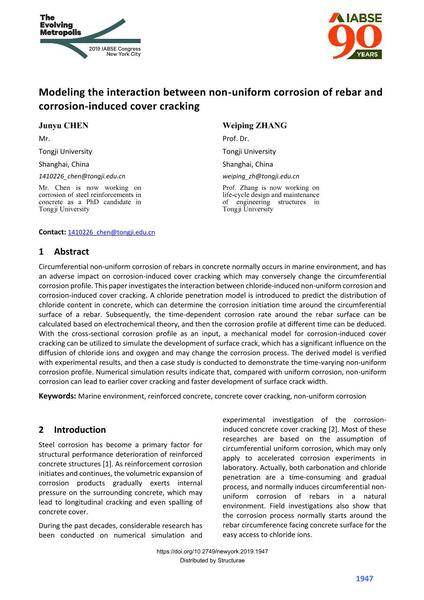Modeling the interaction between non-uniform corrosion of rebar and corrosion-induced cover cracking

|
|
|||||||||||
Bibliografische Angaben
| Autor(en): |
Junyu Chen
(Tongji University)
Weiping Zhang (Tongji University) |
||||
|---|---|---|---|---|---|
| Medium: | Tagungsbeitrag | ||||
| Sprache(n): | Englisch | ||||
| Tagung: | IABSE Congress: The Evolving Metropolis, New York, NY, USA, 4-6 September 2019 | ||||
| Veröffentlicht in: | The Evolving Metropolis | ||||
|
|||||
| Seite(n): | 1947-1953 | ||||
| Anzahl der Seiten (im PDF): | 7 | ||||
| DOI: | 10.2749/newyork.2019.1947 | ||||
| Abstrakt: |
Circumferential non-uniform corrosion of rebars in concrete normally occurs in marine environment, and has an adverse impact on corrosion-induced cover cracking which may conversely change the circumferential corrosion profile. This paper investigates the interaction between chloride-induced non-uniform corrosion and corrosion-induced cover cracking. A chloride penetration model is introduced to predict the distribution of chloride content in concrete, which can determine the corrosion initiation time around the circumferential surface of a rebar. Subsequently, the time-dependent corrosion rate around the rebar surface can be calculated based on electrochemical theory, and then the corrosion profile at different time can be deduced. With the cross-sectional corrosion profile as an input, a mechanical model for corrosion-induced cover cracking can be utilized to simulate the development of surface crack, which has a significant influence on the diffusion of chloride ions and oxygen and may change the corrosion process. The derived model is verified with experimental results, and then a case study is conducted to demonstrate the time-varying non-uniform corrosion profile. Numerical simulation results indicate that, compared with uniform corrosion, non-uniform corrosion can lead to earlier cover cracking and faster development of surface crack width. |
||||
| Stichwörter: |
Stahlbeton
|
||||
